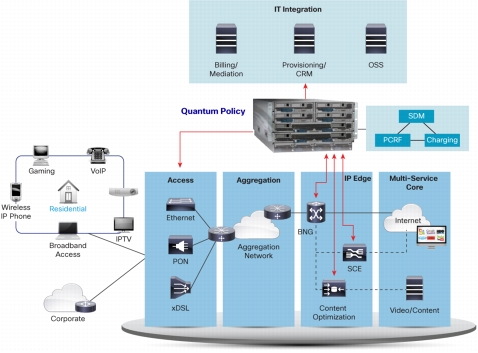|
|
Solution Overview
• Rapidly roll out new services and promotions
• Deploy resource and admission control, validate available bandwidth, and automatically allocate real-time service
• Dynamically manage broadband performance
• Integrate advanced broadband, value-added, and third-party services
• Subscriber demands for new voice, video, and data applications are accelerating, and data transfers over broadband connections are reaching unprecedented levels. Operators will see increased revenue over the short term, but for the long term they face innumerable challenges as a result of the rapid pace of demand for broadband data access. They will need a solution that not only addresses network policy and bandwidth management, but also helps enable new applications within an easily customized, highly personalized experience
Figure 1. Cisco Quantum Policy Suite Architecture

• Cisco Quantum Policy Suite for BNG provides dynamic subscriber management functions for both residential and business broadband subscribers, giving operators the capability to directly monetize their networks by mapping specific features to specific revenue streams. Cisco Quantum Policy Suite for BNG is ideal for use in all types of broadband deployments, enabling operators to deploy network- and application-centered policy technology that accommodates wholesale and retail broadband business models.
Features and Benefits
Features and Benefits
• Reduce the time required to create new services and applications
• Boost revenue by rapidly rolling out new applications
• Avoid the need for custom code when rolling out tiered and personalized service packages by using premade templates and customized portals
• Help ensure network integrity by dynamically managing broadband performance
• Streamline network policy control by combining multiple services, such as Internet, email, triple-play (voice, video, and data services), and security, as well as easily integrate a range of advanced broadband, value-added, and third-party services
Core Modules
Policy Module
• Tiered services and per-user quality of service (QoS) that facilitates subscriber base segmentation to offer differentiated services and pricing - for example, premium high-speed access that is targeted to business users and gamers versus basic access speeds for email and browsing users
• Bandwidth on demand and turbo boost, allowing subscribers to increase their bandwidth either on a predetermined schedule or on demand - such as for a streaming video session or business demonstration
• Session usage data record generation
• Subscriber account creation and service selection portal API that interfaces with a service provider's portal, helping give end users secure control over their service experience
Charging Module
• Flexible charging detail record (CDR) generation with rule-based filters - for example, to strip out non-billing-related fields or augment accounting records with data from other sources
• Aggregation of partial CDRs and correlation of CDRs from multiple sources
• Ability to dynamically charge services based on real-time rating rules
• Real-time and/or offline charging and policy enforcement
• Prepaid, postpaid, and hybrid payment models
Optional Feature Modules
Subscriber Management Module
• Subscriber data management and user data persistence
• Account, subaccount, and user group management
• Identity management
• Association with service plans
• Account balance management
• Provisioning integration
• Subscriber self-registration
Quota Module
• Tracking of subscriber session- and/or application-specific usage against daily, weekly, or monthly billing cycle fair use usage limits; provides the ability to block, downgrade, or restrict subscriber usage when exceeding usage limits
• Alerts for subscribers when they are approaching limits based on user-personalized (or plan default) threshold
• Options to extend a user's quotas, including pay-as-you-go (PAYG) top-ups
• Ability to give users an incentive to perform data-intensive transfers, such as online backups, during off-peak hours by using time-of-day windows
• Premium, value-added options to up-sell subscribers - for example, exemptions of specific traffic, such as social networking, from plan usage limits
• Subscriber usage balance management, including daily, weekly, monthly recurring, rollover, and single-use plans, and top-ups
• Quota management portal API that allows subscribers to view their quota usage and prevent bill shock by tracking and extending quotas
Geographic High Availability
• Geographical redundancy and disaster recovery and can be deployed in active-active mode and active-passive mode
Table 1. Features and Benefits
System Requirements
Table 2. System Requirements
|
CPU |
2 Intel® Xeon® X5650s or higher speed |
|
Disk space |
2 100-GB or higher solid state disks (SSDs) with hardware Redundant Array of Independent Disks (RAID) 1 |
|
Virtualization |
Must be listed on the VMware Hardware Compatibility List (HCL): http://www.vmware.com/resources/compatibility/search.php |
|
Hardware |
4 commercial blade servers; for example, 4 Cisco UCS B-Series blade servers or equivalent |
|
Memory |
24 GB RAM for 0 to 500,000 subscribers 48 GB RAM for 500,001 to 1,000,000 subscribers 72 GB RAM for greater than 1,000,000 subscribers |
|
Network interface |
Dual Gigabit Ethernet ports |
Why Cisco?
Service and Support
For More Information